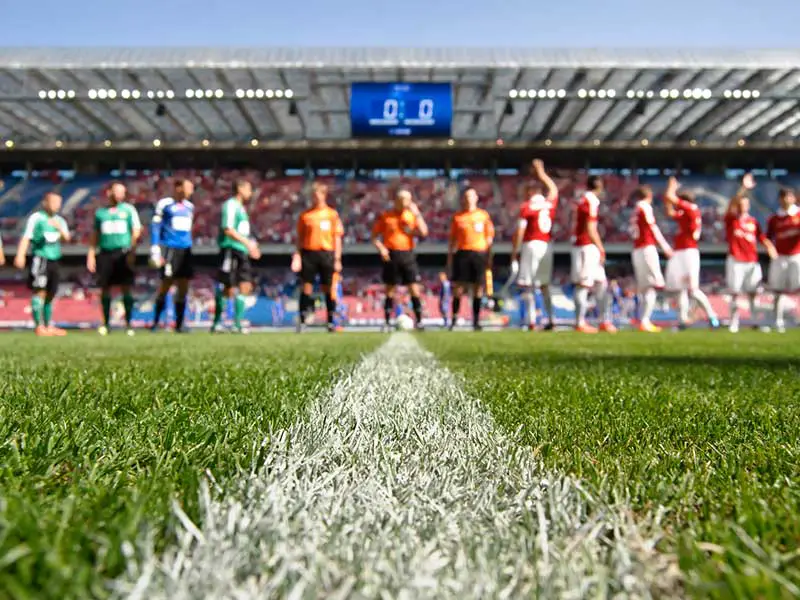Why Do Soccer Games Sometimes End in a Tie?
With many major national sports’ focus on producing positive outcomes in one way or another – for example basketball and ice hockey – it can be difficult for American and Canadian sports fans to accept that soccer games can end with the scores tied, and neither team having won.
It might add to the confusion if you don’t know too much about soccer that there are some instances when, following the game ending in a draw over 90 minutes, there are a few ways that a game can be continued to achieve a positive result – and in the history of the game, there has been one further method, but more of that later.
But these only apply when teams are competing in cup competitions, or in an end-of-season play-off to decide promotion, and not during their regular league seasons.
How common is it for a soccer game to end in a tie?
No matter what league or level the game is being played in, games will often end with both teams having scored the same number of goals – or indeed, none – at the end of the regulation playing period of 90 minutes, split into two equal halves of 45 minutes, with a half-time interval of up to 15 minutes.

Soccer was conceived as a game played largely between gentlemen, and so it was quite acceptable for matches to end in ‘an honourable draw’, no matter how much one team’s play in the game itself may have warranted a win.
Generally speaking, about one soccer game in every five ends in a draw. This broad statistic is used as the basis for the soccer pools, a form of gambling in which participants try to guess at least eight games which will end in a draw from a list of 49 matches all being played on the same day.
What are the consequences for both teams of a drawn match?
The most common formula for allocating the points which ultimately decide teams’ league rankings at the end of a season is that the team which wins a game earns three points, and the losing team zero.
But when a soccer game which is part of the regular league season finishes in a draw, each team is awarded one point. This is true no matter how many goals both teams score – so a 0-0 result (a goalless draw) and a 4-4 draw (a score draw) will both earn each team one league point.
There could be instances when a team might benefit from ‘playing for a draw’, rather than making every effort to win the game, and ending up actually losing it, especially when two teams which are not closely matched in terms of skill and their league positions play each other.
Add to this the fact that a soccer match, while obviously a team game, can so easily be greatly affected by a single player making an error, or being the unfortunate cause of their team conceding a goal, and you can see why a drawn outcome is rarely seen as a major surprise.
What Is Needed For A Soccer Match To End As A Draw?
Simply, a draw is the result when both teams have scored the same number of goals – or neither team has scored a goal – when full-time is signalled by the referee.

A drawn game certainly need not be a dull game. It is quite common for both teams to try their hardest to win a game, and to create any number of chances to score a goal, yet for the match to finish as a draw, or – as we also commonly call it in the U.K., ‘all square’.
Is A Draw In A Soccer Game A Good Or A Bad Result?
This very much depends on the positions of the respective teams in their league table, and whether one of the two teams, on the basis of their recent results before the game, could have expected to have a far greater chance of winning.
Soccer managers often talk in terms of a draw being a good result, if their team is much lower down the rankings in their league than their opponents, or if one team played far better and had far more chances to score more goals.
In some rarer instances, particularly in a knockout cup competition, where teams which play in one of the lower-ranking divisions – or possibly even in a more junior league – get the chance to play one of the elite teams, then a draw might even be considered a shock result, because the higher-ranked team would have been expected to win quite easily.

When they play a team from a higher league, many smaller teams may adjust their tactics in the hope of the game finishing as a draw. Then they will either get the chance to have a replay either at their own ground – giving their fans a rare chance to watch a better-known team in their locality – or to go and enjoy the experience of travelling for a day out and to watch a game at the bigger team’s stadium.
Whether a draw can be considered a positive or a negative outcome for either team might also depend on which was the home team. Because it is widely considered that playing at home gives a team a decided advantage – mostly because they will have a much larger contingent of fans supporting them – more credit will be given to the away team for earning a draw.
So you will often hear soccer players, managers or coaches, and commentators talking in terms of a drawn game being ‘a good away point’ for the visiting team, or ‘two points lost/dropped’ for the home team, because they should have had the better chance to win.
Does A Draw Mean A Boring Game?
Absolutely not necessarily. Some managers may send their team out and ask them to play in a defensive formation and with tactics which they hope will see them draw the game, rather than lose it, and then see a draw as a good result.
But if two teams are especially closely matched, and both play as though they were trying their best to win, a drawn game can be considered very exciting by the fans.
This may even be the case despite one of the two teams having been the clear favourite to win beforehand.
Modern soccer games are awash with statistics, much like baseball, American football, and indeed pretty much any sport these days.
So if one soccer team achieves a draw against their opponents, despite having had much less possession of the ball, the ball having spent most of the time in the half of the field being protected by their defense, and even their opponents having had more clear chances to score a goal, then they may emerge from the match with more credit and praise from their fans than their opponents.
They may have achieved what’s seen as a creditable result because they fought harder – and perhaps in some ways were luckier – to finish with the scores level at the end of the game.
Indeed, you will hear many soccer purists say that the unpredictability of results, on a week-to-week basis, is one of the greatest attractions of the game. So you might even see fans in some situations celebrating their team earning a draw almost as much as if they had won the match.
Can A Soccer Team Actually Earn A Positive Outcome From A Game Ending In A Draw?
Yes, there are a number of high-profile examples where this can happen.
For example, in a competition where the teams are divided into a number of groups, in which they play each other once in a mini-league format to earn the chance to progress to the next stage of the competition – as happens at the F.I.F.A. World Cup, and in the U.E.F.A. Champions’ League, for example – depending on previous results, a draw, and the single point earned from it, might earn a team a place in the next phase of the competition, yet also not be enough for their opponents to do so, on the basis of their previous results.
In the earlier days of soccer, there were quite commonly instances when both teams in a cup competition soccer game would still be level, despite them having played a full 90 minutes, and then extra-time – and even played a two-legged match – and the scores have still been tied after all that playing.

In these rare instances, the outcome of the game would be settled by the referee tossing a coin, and the team captain who called the toss correctly would earn his team a place in the next round.
The most high-profile instance of such a result was the quarter-final of the European Cup – the predecessor of today’s Champions’ League – in 1965. When Liverpool F.C. and Cologne of the German Bundesliga played each other over two legs and neither team could score, a play-off game was arranged at a neutral venue. However, this game, too, ended in a draw, so a coin toss was agreed to decide the outcome. The Liverpool captain, defense player Ron Yeats, called the toss correctly as ‘heads’ – at the second attempt, after the coin landed edge-down in a divot at the referee’s first attempt – and so the English team can claim to be one of a tiny number in soccer history to have won a game which actually, on the field, ended in a draw – in this case not once, but three times!
As this incident, and quite a few more besides, prove, despite a draw being – for obvious reasons – competitively less desirable than a win as the outcome of a game, there are regularly instances when it happens, and even occasions when the game will have been exciting, and although very rare, one team will benefit from the result far more than the other.
